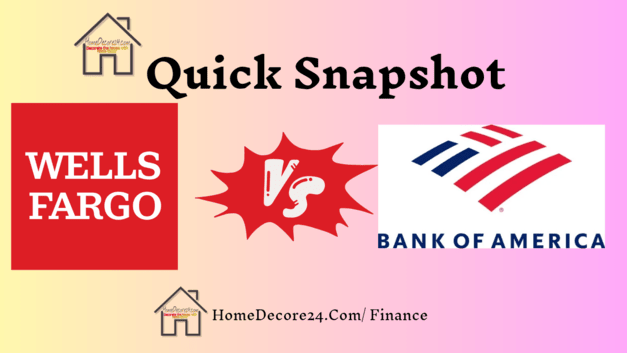
| Feature | Wells Fargo | Bank of America |
|---|---|---|
| Checking Account Fees | $10 (Everyday Checking) | $12 (Advantage Plus Banking®) |
| Minimum to Open | $25 | $100 |
| Savings Account APY | 0.01% | 0.01% |
| CD Rates | 1.50% for 1-year term | 0.03% for 1-year term |
| Overdraft Fee | $35 per overdraft (max 3/day) | $10 per overdraft (max 2/day) |
| ATMs | 12,000+ ATMs | 16,000+ ATMs |
| Customer Service Hours | 24/7 availability by phone | Limited hours (8 a.m. to 11 p.m. weekdays) |
| Mobile App Rating | 4.8 (iOS), 4.6 (Android) | 4.8 (iOS), 4.7 (Android) |
| Branch Locations | 4,700 in 35+ states | 4,100 in 35+ states |
Checking Accounts: Wells Fargo vs. Bank of America
Both banks offer standard checking accounts with monthly fees, but the key difference lies in the conditions for waiving those fees.
Wells Fargo Everyday Checking
- Monthly Fee: $10 (waived with a $500 minimum balance or $500 in direct deposits)
- Minimum Deposit: $25 to open an account
- Bonus Offer: Up to $300 for new accounts (expires 09/25/2024)
Bank of America Advantage Plus Banking®
- Monthly Fee: $12 (waived with a $1,500 minimum balance, $250 in direct deposits, or enrollment in Preferred Rewards)
- Minimum Deposit: $100 to open an account
- Bonus Offer: $200 for new accounts (expires 09/30/2024)
Verdict: Wells Fargo edges out Bank of America for checking accounts due to the lower minimum deposit and slightly more lenient requirements to waive fees.
Read More: Wells Fargo Mortgage Review
Savings Accounts: Wells Fargo vs. Bank of America
If you’re looking for a basic savings account, both banks offer low-interest rates. However, neither institution is ideal for earning significant interest on savings.
Wells Fargo Way2Save® Savings
- APY: 0.01%
- Monthly Fee: $5 (waived with a $300 minimum balance or automatic transfers)
- Minimum Deposit: $25 to open an account
Bank of America Advantage Savings
- APY: 0.01% (up to 0.04% with Preferred Rewards)
- Monthly Fee: $8 (waived with a $500 minimum balance or Preferred Rewards)
- Minimum Deposit: $100 to open an account
Verdict: Wells Fargo has a lower minimum deposit, but Bank of America offers the opportunity for a slightly higher APY for larger balances. Neither bank is particularly competitive in savings rates compared to online banks.
Certificates of Deposit (CDs): Wells Fargo vs. Bank of America
Both banks provide Certificates of Deposit (CDs) as savings options. However, their rates and terms vary significantly.
Wells Fargo CD Rates
- 1-Year APY: 1.50%
- 5-Year APY: Rates not available online (call or visit a branch)
- Minimum Deposit: $2,500
Bank of America CD Rates
- 1-Year APY: 0.03%
- 5-Year APY: 0.03%
- Minimum Deposit: $1,000
Verdict: Wells Fargo offers significantly better CD rates for short-term savings, but Bank of America’s lower minimum deposit makes it more accessible for smaller investors. For the highest rates, neither bank is as competitive as many online-only banks.
Overdraft Fees and Protection
Both banks charge fees for overdrafts, but there are key differences in how they handle these fees.
Wells Fargo
- Overdraft Fee: $35 (maximum 3 per day)
- Overdraft Protection: Free transfer from a linked account
- Extended Overdraft Fee: None
Bank of America
- Overdraft Fee: $10 (maximum 2 per day)
- Overdraft Protection: $12 per transfer from a linked account
- Extended Overdraft Fee: None
Verdict: Bank of America offers more favorable overdraft terms with lower fees compared to Wells Fargo.
Customer Service and Accessibility
When it comes to customer service, Wells Fargo takes the lead with 24/7 phone support, while Bank of America offers more limited hours.
Wells Fargo
- Customer Service: 24/7 phone support, social media support
- Branch Locations: 4,700 across 35+ states
- ATMs: 12,000+ nationwide
Bank of America
- Customer Service: Available from 8 a.m. to 11 p.m. ET (weekdays), reduced hours on weekends
- Branch Locations: 4,100 across 35+ states
- ATMs: 16,000+ nationwide
Verdict: If you prioritize customer service and around-the-clock access, Wells Fargo is the better option. However, Bank of America’s larger ATM network may be more convenient for frequent cash withdrawals.
Mobile and Online Banking
Both banks offer highly rated mobile apps, making it easy to manage accounts on the go.
- Wells Fargo: 4.8/5 on the Apple App Store, 4.6/5 on Google Play
- Bank of America: 4.8/5 on the Apple App Store, 4.7/5 on Google Play
Verdict: Both banks provide robust online and mobile banking experiences, so you can’t go wrong with either.
Final Verdict: Wells Fargo vs. Bank of America – Which is Best for You?
When choosing between Wells Fargo and Bank of America, consider the following:
- Choose Wells Fargo if you value 24/7 customer service, want lower minimum deposits for checking and savings accounts, and prefer better CD rates.
- Choose Bank of America if you need a larger ATM network, prefer lower overdraft fees, and are interested in higher savings rates with larger balances.
For those who prioritize high interest rates on savings or CDs, online banks might be a better alternative. However, if you need access to physical branches and comprehensive banking services, both Wells Fargo and Bank of America provide solid options.
FAQs
Is Bank of America or Wells Fargo better?
The Wells Fargo Everyday Checking account edges out the Bank of America Advantage Plus Banking® due to its lower minimum opening deposit and monthly service fee. Additionally, it offers a larger bonus for new customers. However, Bank of America makes it a bit easier to meet the criteria for waiving monthly fees.
Is Bank of America bigger than Wells Fargo?
Bank of America is the second biggest bank, with more than $2.45 trillion in assets. Wells Fargo is the third biggest, holding over $1.7 trillion in assets.
Who is Wells Fargo biggest competitor?
Wells Fargo’s primary competitors are the other three members of the “big four” U.S. banks: JPMorgan Chase, Bank of America, and Citigroup. Together, these four institutions control about 40% to 45% of all bank deposits nationwide and handle a significant portion of personal and commercial accounts across the United States.
✓ Pros And Cons Of Savings Account








